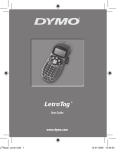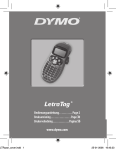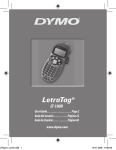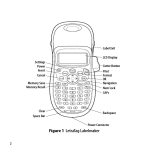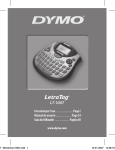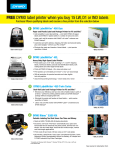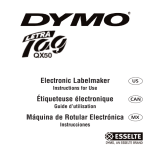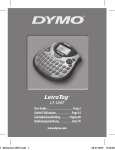Download Dymo LETRATAG 100T User guide
Transcript
LT Mom US_cover.indd 1 ® LT-100T User Guide 29-09-2006 09:14:32 LetraTag User Guide Memory Memory Label Exit Save Recall Print LCD Display Power Connector Power Cutter Insert Format Settings Cancel OK Navigation Cancel Num Lock CAPs Clear Clear Backspace Space Bar Figure 1 DYMO LetraTag Labelmaker 2 About Your New Labelmaker With your new DYMO LetraTag® labelmaker, you can create a wide variety of high-quality, self-adhesive labels. You can choose to print your labels in many different font sizes and styles. The labelmaker uses DYMO LetraTag (LT) 12 mm label cassettes. LT cassettes are available in multiple colors of plastic and metallic tape, and in white iron-on tape. Visit www.dymo.com for information on obtaining labels and accessories for your labelmaker. Warranty Registration Please complete the warranty registration card and return it to the appropriate Customer Support address within seven days. Visit www.dymo.com/registration for details or to register online. Getting Started Follow the instructions in this section to print your first label. Connecting the Power The labelmaker is powered by standard batteries or an AC power adapter. To save power, the labelmaker will automatically turn off after two minutes of inactivity. 3 Inserting the Batteries The labelmaker uses four high-capacity AA alkaline batteries. To insert the batteries 1. Remove the battery compartment cover. See Figure 2. 2. Insert the batteries following the polarity markings (+ and –). 3. Replace the cover. ! Remove the batteries if the labelmaker will not be used for a long period of time. Figure 2 Connecting the Optional Power Adapter An optional 9 Volt, 1.5 A power adapter can also be used to power the labelmaker. Connecting the AC adapter to the labelmaker disconnects the batteries as a power source. To connect the power adapter 1. Plug the power adapter into the power connector on the top of the labelmaker. 2. Plug the other end of the power adapter into a power outlet. 4 ! Make sure the labelmaker power is turned off before you disconnect the power adapter from the main power source. Otherwise, your most recent memory settings will be lost. Inserting the Label Cassette Your labelmaker comes with one label cassette. Visit www.dymo.com for information about purchasing additional label cassettes. To insert the label cassette 1. Lift the label cassette cover to open the label compartment. See Figure 3. Figure 3 ! Before using the labelmaker for the first time, remove the protective cardboard insert from label exit slot. See Figure 4. 2. Insert the cassette with the label positioned between the print head and pinch roller. Remove cardboard insert Figure 4 3. Press firmly until cassette clicks into place. 5 4. Close the label cassette cover and press power. to turn on the Selecting a Language The first time you turn on the power, you are asked to select your desired language. By default, the language is set to English. The language option you choose determines the character set that is available. To select a language 1. Press . 2. Use the up or down arrow key to select Language and press . 3. Use the up or down arrow key to select the language you want and press . Setting the Date and Time You need to set the current date and time so that the date is correct if you choose to automatically insert a date on your label. To set the date and time 1. Press . 2. Use the up or down arrow key to select Set Date and press The default date is displayed. 6 . 3. Use the left or right arrow key to move the cursor over each setting (month, day, and year) and use the up or down arrow keys to increase or decrease the value. 4. When finished, press .The default time is displayed. 5. Use the left or right arrow key to move the cursor over each setting (hours and minutes) and use the up or down arrow keys to increase or decrease the value. 6. When finished, press . Printing Your First Label You are now ready to print your first label. To print a label 1. Enter text to create a simple label. 2. Press . 3. Press the cutter button to cut the label. Congratulations! You printed your first label. Continue reading to learn more about the options available for creating labels. 7 Getting to Know the Labelmaker Become familiar with the location of the feature and function keys on your labelmaker. Refer to Figure 1 on the inside front cover. The following sections describe each feature in detail. Power The button turns the power on and off. After two minutes of no activity, the power is switched off automatically. The last label created is remembered and displayed when the power is turned back on. The previously selected style settings are also restored. You can also press to cancel printing and return to edit mode. LCD Display You can enter up to 100 characters and spaces on a label; however, the display will only show a small portion of the characters. And, with DYMO’s exclusive graphical Font size # lines CAPs Num Lock display, any formatting you add is visible instantly. For example, the italics and rounded border added to the text in Figure 5 are clearly displayed. Feature indicators appear along the top of the display to let you know when a feature is selected. 8 Figure 5 CAPS Mode The key toggles capitalization on or off. When CAPS mode is turned on, the CAPS mode indicator is shown on the display and all letters that you enter will be capitalized. The default setting is CAPS mode on. When CAPS mode is off, all letters appear in lower case. Num Lock The key provides access to the numbers located on some of the alphabetic keys. When Num Lock mode is turned on, the Num Lock indicator is shown on the display and the numbers 0 through 9 appear when you press the corresponding letter keys. Num Lock is turned off by default. Backspace The key removes the character to the left of the cursor. Clear The Clear key clears all label text and formatting. Navigation Keys You can review and edit your label using the left and right arrow keys on the Navigation key. You can navigate through menu selections using the up and down arrow keys, and then press to make a selection. 9 Cancel The key allows you to exit from a menu without making a selection or to cancel an action. Cancel Format The key displays the Size, Style, and Borders submenus. These formatting features are described later in this User Guide. Insert The key allows you to insert symbols, a second line, or the date on your label. Settings The key displays the Preview, Language, Set Date, and Set Contrast submenus. These features are described later in this User Guide. Formatting Your Label You can choose from a number of formatting options to enhance the appearance of your labels. 10 Changing the Font Size Five font sizes are available for your labels: Extra Small, Small, Medium, Large, and Extra Large. When you select a size, that size applies to all characters on a label. To set the font size 1. Press the key. 2. Use the up or down arrow keys to select Size and press . 3. Use the up or down arrow keys to select the desired font size and then press . Adding Font Styles You can choose from six different font styles: Normal Bold Italic Outline Shadow Vertical When you select a style, that style applies to all characters. Styles can be used with alphanumeric characters and some symbols. 11 To set the font style 1. Press . 2. Use the up or down arrow key to select Style and press . 3. Use the up or down arrow key to select a font style and press . Creating Two-Line Labels You can print a maximum of two lines on labels. To create a two-line label 1. Type the text for the first line and press . 2. Use the arrow keys to select Second Line and press .A multi-line symbol is inserted at the end of the first line, but will not print on the label. 3. Type the text for the second line. Adding the Date You can insert the date on your label. The date format is MMM DD, YY (US) or DD MMM YY (Europe) depending upon the version of your labelmaker. To insert the date 1. Press . 2. Select Date and press 12 . Adding Box and Underline Styles You can highlight your text by choosing a box or underline style. Underline Edged Square Train Pointed Sweet Hearts Rounded Flowers Crocodile A label can be underlined or enclosed in a box, but not both together. To add an underline or box style 1. Press . 2. Select Borders, and press . 3. Select underline or a box style and press . On two-line labels, both lines are underlined. In box style mode, all the lines are enclosed in one box style. 13 Using Symbols and Special Characters Symbols and other special characters can be added to your labels. Adding Symbols The labelmaker supports the extended symbol set shown below. 14 To insert a symbol 1. Press , select Symbols, and press . The first row of symbols shown in the table appears in the display. 2. Use the arrow keys to move to the desired symbol. The left and right arrows move horizontally along a row of symbols. The up and down arrow keys scroll vertically through the rows of symbols. 3. When you locate the symbol, press to add the symbol to your label. The labelmaker remembers the last symbol used. The next time you choose to insert a symbol, the last symbol that you used is automatically selected. Adding International Characters The labelmaker supports the extended Latin character set using RACE technology. Similar to using a mobile phone keypad, when you hold down a letter key for longer than one second, you will scroll through variations on that letter. To insert the character, release the key when the desired character appears. For example, if French is selected as the language and you hold down the letter a, you will see a à â æ and so on through all the variations available. The character variations and the order in which the variations appear depend on the language you have selected to use. 15 Printing Options You can preview your label and adjust the printing contrast. Previewing Your Label You can preview the text or format of your label prior to printing. A two-line label is previewed as a single-line label with a line break character between the two lines. To preview your label 1. Press . 2. Select Preview and press . The text of the label scrolls across the display. Adjusting the Print Contrast You can adjust the print contrast to fine tune the print quality of your label. To set the contrast 1. Press . 2. Select Set Contrast and press . 3. Use the arrow keys to select a contrast setting and press . 16 Using Labelmaker Memory The labelmaker has a powerful memory feature that allows you to store the text of up to nine labels you use frequently. Storing Label Text You can store up to nine specific labels you use frequently. To store the current label text 1. Press . The first of the memory fields is displayed. 2. Use the arrow keys to move through the fields. You can store new text in any of the memory locations. 3. Select a memory location and press . Your label text is saved and you are returned to the label. Recalling Stored Labels You can easily recall labels stored in memory to use at a later time. To recall labels 1. Press . The first memory location is displayed similar to storing a label or format. 2. Use the arrow keys to select a label to recall and press . To clear a memory field, first recall a label and then press . Clear 17 Caring for Your Labelmaker Your labelmaker is designed to give you long and trouble-free service, while requiring very little maintenance. Clean your labelmaker from time to time to keep it working properly. Clean the cutter blade each time you replace the label cassette. Press in To clean the cutter blade and hold 1. Dampen a cotton ball with alcohol. 2. Remove the label cassette. 3. Place the tip of a ball-point pen or pencil on the black post as shown in Print Head Figure 6, and press the post down. Figure 6 4. While holding down the post, press and hold the cutter lever to expose the cutter blade. 5. Release the post and clean both sides of the blade with the cotton ball. 6. Release the cutter lever. ! You can also follow this procedure if the cutter blade becomes lodged in the forward position and will not move. 18 To clean the print head 1. Remove the label cassette. 2. Remove the cleaning tool from inside the label compartment cover. 3. Gently wipe the padded side of the tool across the print head. See Figure 6. 19 Troubleshooting Review the following possible solutions if you encounter a problem while using your labelmaker. Problem/Error Message Solution No display • Ensure the labelmaker is turned on. • Replace discharged batteries. Poor Print Quality • • • • Poor Cutter Performance Clean the cutter blade. See Caring for Your Labelmaker. Printing No action required. Message disappears when printing is finished. Replace batteries or attach power adapter. Ensure label cassette is installed properly. Clean the print head. Replace the label cassette. Too many characters Exceeded maximum number of Delete some or all of the buffer text. characters in buffer. Battery low Batteries almost discharged. Replace batteries or connect AC power adapter. Tape Jam • Remove jammed label; replace label cassette. Motor is stalled due to label jam. • Clean cutter blade. If you still need assistance, contact DYMO Customer Support. See Contacting Customer Support at the back of this User Guide to locate the contact number for your country. 20 Documentation Feedback We are constantly working to produce the highest quality documentation for our products. We welcome your feedback. Send us your comments or suggestions about our user guides. Please include the following information with your feedback: • Product name, model number, and User Guide page number • Brief description of instructions that are inaccurate or unclear, areas where more detail is needed, and so on We also welcome your suggestions about additional topics you would like to see covered in the documentation. Send email messages to: [email protected] Please keep in mind that this email address is only for documentation feedback. If you have a technical question, please contact Customer Support. This product is CE marked in accordance with the EMC directive and the low voltage directive and is designed to conform with the following international standards: US FCC Class B Compatibility Safety - EN 60950, IEC 950, UL 1950 EMC Compatibility EN 61000 3-2/3; EN 61000 4-2/3/4/5/6/8/11; ENV 50204; EU Immunity - EN 55024 & addendum A1, A2 Electromagnetic Compatibility (EMC) Information Technology equipment, Immunity Characteristics Emissions – EN 61000-6-3: Electromagnetic Compatibility (EMC) - Part 6: Generic Standards - Section 3: Emission standard for residential, commercial and light industrial environments. RoHS 2002/95/EC 21 22 Contacting Customer Support The following table provides a list of telephone numbers for DYMO Support departments. You can also reach DYMO at www.dymo.com. Country Telephone Fax Australia 1800/ 633 868 1800/ 817 558 Canada (800) 263-6105 (905) 890-2347 Mexico +01 5368 2066 New Zealand 0800 803 966 United States (203) 588-2500 0800 737 212 LTRazor_back.indd 1 ©2006 DYMO A Newell Rubbermaid Company DYMO Corporation 44 Commerce Road Stamford, CT 06902 www.dymo.com 23-01-2006 16:51:08
























